
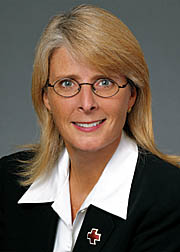 Theresa Bischoff heads the American Red Cross in Greater New York.
Theresa Bischoff heads the American Red Cross in Greater New York. |
First Responder
By Rika Nazem
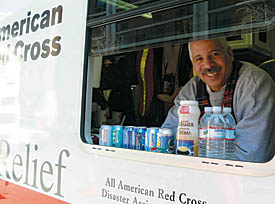
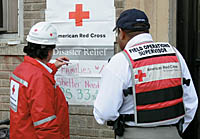
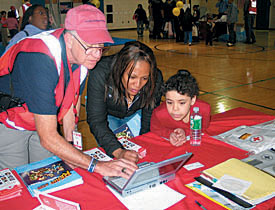
(Top) A Red Cross volunteer in the Greater New York Chapter staffs an emergency response vehicle during the May 2007 crane collapse in New York City.
(Middle) Volunteers set up disaster operations after a Bronx fire.
(Bottom) Members of the community attend a Red Cross Preparedness Event.
|
"Public firms focus on maximizing shareholder value; the American Red Cross in Greater New York focuses on maximizing community value," said the organization's CEO, Theresa Bischoff (MBA '91). Named in 2004 by the New York Daily News as one of the 100 most influential women in New York City, Bischoff leads a small community herself: 200 paid staff and 4,000 volunteers who serve about nine million people in metropolitan New York.
While most people recognize the American Red Cross logo, the extent of the organization's activities may be less well-known. Bischoff explained: "The Red Cross provides humanitarian support to people who are impacted by disaster — everything from terrorist attacks, natural disasters, building fires, and water main breaks. My area deals with anywhere from eight to 10 incidents per day. It means finding homes for people who may have lost theirs, or working with a city agency after a flood, or aiding in completing paperwork. It may not sound like a big deal when, for example, a fire rips through neighborhood homes, but it is a big deal to the people who have to be relocated. That is where we come in."
But that's just the beginning. In addition to its humanitarian efforts, the Red Cross provides community programs to educate the populace on disaster preparedness, from kits to evacuation techniques, and trains volunteers. "Our volunteers are passionate about what they do and are committed to our organization. We rely on our volunteers as the bench strength, in addition to community and government support," she said. Volunteers have participated in relief efforts relating to the summer floods in the Midwest and the cyclone in Myanmar. "We work with organizations here and abroad to help people during a crisis. We wish we could reduce the number of incidents; unfortunately, we cannot. But what we can do is prepare people for disaster and give hope to those who find themselves affected by it." As of May 31, 2008, the staff and volunteers of the American Red Cross in Greater New York have responded to more than 1,200 fires, building collapses, blackouts, and other emergencies, and have assisted nearly 6,000 adults and children with food, shelter, and/or counseling following a disaster.
Bischoff said that while each day is different at the Red Cross, she uses her finance skills, which she gained from Stern while a student in the Langone Part-time MBA program, every day. While attending the Langone program at night, she began working at Squibb Corp., and then spent nearly 20 years at New York University Hospital Center, the last five years as president. There she experienced the ultimate in crisis management. "September 11th happened, and the proximity of the hospital and the medical examiner's office to downtown Manhattan drew a lot of victims and families there," she explained.
Aside from her work at the American Red Cross, Bischoff is known as one of the country's most effective and articulate advocates for academic medicine. "I recognized the value of good healthcare when my parents became ill, and have a passion for helping people in this way," she said. She has played important leadership roles, championing hospitals and medical schools on the local and national level. She has held many prominent positions in the industry, including chair of the Greater New York Hospital Association and the Association of American Medical Colleges, which represents 525 accredited medical schools and major teaching hospitals.
She is involved with NYU's School of Medicine, Wagner School of Public Health, and Stern, where she regularly speaks at events. Bischoff said she is especially impressed with Stern's program in social responsibility. "I think it's important that business students understand that becoming involved in the community creates a better environment for everyone," she added.
Bischoff said that leading an organization that is focused on service and the community has been rewarding. "I am passionate about waking up to work with people who are so committed to our mission. Our volunteers are amazing people and allow us to do great things." She added: "I am fortunate to find myself at the intersection of what I am good at and what I like. And that is my advice to people starting out. Find a way to do what you're passionate about and what you do well."
 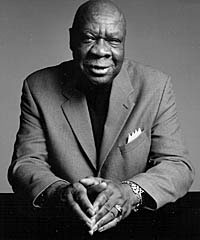
(Left) Cal Ramsey played forward for the New York Knicks in 1959 and 1960. Today (right) he serves as the Knicks' director of special projects and community relations representative. |
Hoop Hero with a Heart
By Jenny Owen
Former NBA forward Calvin Ramsey (BS '59) is a New York fixture and one of the City's home-grown heroes. Because of his long devotion to public service and to the New York Knicks, his community has dubbed him the Mayor of Harlem.
As director of special projects and community relations representative for the Knicks, he's a goodwill ambassador for the team and its affiliated New York Liberty women's basketball team, working with them on a host of community outreach efforts, including their Garden of Dreams programs, Read to Achieve program, Knicks Summer Basketball Camp, and Junior Knicks League.
Ramsey has been involved with the Knicks since playing for them in 1959 and 1960 after a handful of games with the St. Louis Hawks, who drafted him in 1959 following his graduation from NYU's School of Commerce, Accounts, and Finance, as Stern was then known. He averaged 11 points and seven rebounds per game, but the next year he was released and joined the Syracuse Nationals. "At the time, there was a quota system on African-American athletes in the NBA," he explained. "If you weren't a great player like Wilt Chamberlain or Oscar Robertson, you had a small chance of making the team. Remember, in those days, there were only eight teams in the NBA and 10 players on the team, so there were only 80 jobs. Now there are 30 teams with 15 players, so there are a lot more jobs. I wasn't great, but I was good."
After a short stint with Syracuse, Ramsey joined the Eastern League in Pennsylvania — now known as the Continental Basketball Association. But during a game, he tore his knee. "When I came out of surgery, my doctor said to me, 'Cal, it's a good thing that you were a good student and that you graduated college and that people like you, because you'll never play basketball again.' My knee was that damaged."
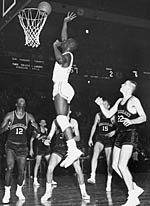 |
(Left) Cal Ramsey scores a basket in the NYU Violets' game against Cincinnati in 1958. Photo: courtesy of New York University Archives, Photograph Collection.
(Below) Ramsey (center) works with the Knicks' Read to Achieve program — one of the many community outreach efforts he supports. |
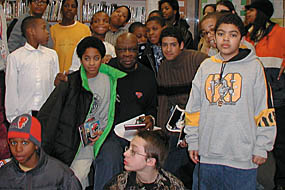 |
|
The injury "forced me to change careers," said Ramsey. His NYU Stern degree and skill in typing enabled him to become a teacher in the South Bronx, where he taught for about seven years. He also briefly served as dean and acting assistant principal at a Harlem public school and ran educational programs for the Urban Coalition and the New York Urban League, where he worked to reduce the size of schools.
Ramsey then took up basketball again, this time as a statistician for William "Red" Holzman, the longtime Knicks coach. Later, he began 10 years as a color commentator for the Knicks, and, in 1986, New York's then-Mayor Ed Koch appointed him chairman of the New York City Sports Commission. In 1991, he was appointed community relations director by then-Knicks President Dave Checketts, "who had a strong belief in working with the youngsters in the New York area."
Ramsey's passion for the Knicks began when he played for NYU, a Division I team that played its home games at Madison Square Garden, the Knicks' home court. He cherishes his Knicks experiences: "The first basket I made playing for the Knicks, when I had a jump shot over Elgin Baylor, and playing against the Detroit Pistons at the Garden and making 15 points and 15 rebounds are moments I'll never forget."
The NBA has changed significantly since Ramsey's tenure. "I signed my first contract for $7,000 and now they're signing contracts for $49 million. Players with my stats today would probably be guaranteed at least $3 million or $4 million," he asserted. As for Ramsey's NYU stats, he set 17 records, some of which still stand. He averaged a record 19.6 rebounds per game in his sophomore year — 17.4 for his career — and, in one game, grabbed 34 rebounds. He was inducted into the NYU Athletics Hall of Fame in 1978, and subsequently into the NYC Sports Hall of Fame, Brooklyn USA Hall of Fame, Basketball Old Timers of America Hall of Fame, and Holcombe Rucker Basketball Hall of Fame.
Ramsey remains deeply involved with his alma mater. He helps recruit, has been an assistant basketball coach for almost three decades, worked with the University's Alumni Relations Office for two decades, and serves on the advisory board of The Preston Robert Tisch Center for NYU's School of Continuing and Professional Studies. He received the NYU President's Alumni Achievement Award in 2004, and he was honored by NYU's Tisch Center for Hospitality, Tourism, and Sports Management as the namesake of the Cal Ramsey Distinguished Lecturer Series, an annual event inaugurated by NBA Commissioner David Stern in spring 2001. Ramsey came to NYU on the advice of his high school coach, who said: "'(1) it's a great academic institution; (2) they have a very strong alumni network, which will help you in the future; and (3) they play their games at the Garden,'" Ramsey explained. "All of those things proved to be very prophetic."
Ramsey is also a constant presence among the city's youngsters, encouraging them to stay in school. "I advise kids to develop their own skills and to apply themselves and to do the best that they can," he said. "I always tell them, 'If you like sports, you play hard — as hard as you can — but then you study a little bit harder.'" He is a member of the board of the Children's Aid Society, the advisory board of YES (Youth Education through Sports), and the Frank McGuire Foundation, which honors high school coaches in the tristate area, and he has been heavily involved with Special Olympics, among many other organizations.
Did you know?
As one of the Big Apple's best-known and most-respected sports figures, Cal Ramsey was featured in a segment of "The Cosby Show" in October 1997. |
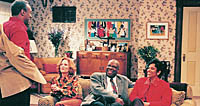 |
He credits community agencies, such as the YMCA, and after-school programs in his neighborhood for instilling in him the importance of education as a youngster. "Those programs were very important in my development — they're where I went after school when my mom was at work," said Ramsey. "That's where I learned to play basketball and baseball."
His love for New York City — "You couldn't get me outta here with a gettin' out machine" — and his appreciation for the value of education drive Ramsey's commitment to serving his community. And despite his many honors, which include nearly 100 public service awards, Ramsey considers his biggest professional accomplishment his ability to "give back to the kinds of organizations that made a difference in my youth."


![]()